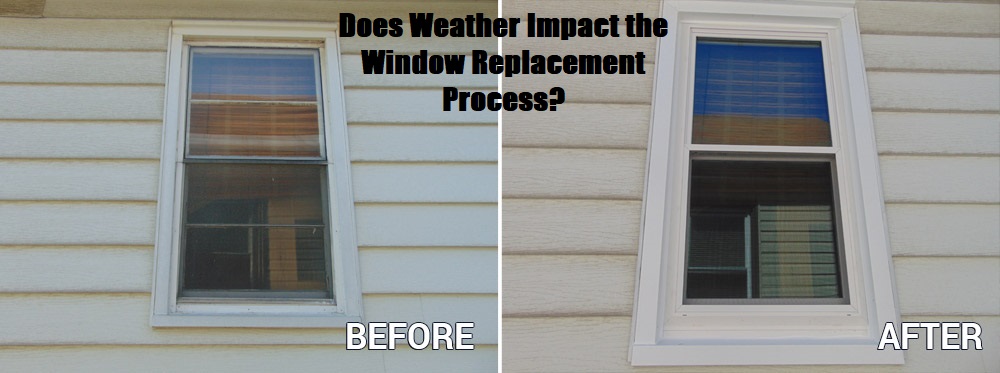When it comes to window replacement, homeowners often wonder if weather conditions impact the process. Weather can be a meaningful factor during window replacement, affecting the installation timeline, product performance, and overall project success.
What Weather Will Impact My Window and Door Installation?
We will explore how different weather conditions can influence the window replacement process and provide insights into the best times to schedule window replacement projects. Comprehending the relationship between weather and window replacement allows homeowners to make informed decisions and ensure a smooth and successful installation.
Effects of different weathers on Window Replacement
Cold Weather
Cold weather poses diverse challenges during the window replacement process. Nevertheless, with suitable precautions, windows can be successfully substituted even in colder climates. Considerations include:
Material Performance:-
Certain window materials, such as vinyl and fiberglass, are excellently suited for cold climates as they are less susceptible to contraction and expansion due to temperature changes. These materials maintain their integrity and structural stability even in extreme cold.
Caulking and Sealants:-
Cold weather can affect the curing and adhesion of caulking and sealants used during window installation. It is essential to use specialized adhesives that are designed for cold-weather applications. Installers may also take extra care to warm the bonds before application to ensure proper adhesion.
Increased Drafts and Heat Loss:-
During window replacement, there may be a brief period when the old window is removed, leaving the opening exposed to the elements. This can usher in increased drafts and heat loss during colder months. Installers should work efficiently and minimize the time that the opening remains exposed.
Hot Weather
Hot weather conditions can also influence the window replacement procedure. Here are some considerations:-
Expansion and Contraction:-
High temperatures can compel materials to expand, including window frames, caulking, and sealants. It is essential to use materials that are designed to withstand temperature fluctuations. Installers should allow for proper expansion gaps during installation to prevent warping or buckling of the window frames.
Sealant Drying Time:-
Hot weather can accelerate sealants’ drying time, making it challenging for installers to achieve proper adhesion. They may need to work quickly and apply sealants in smaller sections to ensure adequate bonding before the sealant dries.
Comfort and Safety:-
Working in hot weather can be physically demanding for installers. They should take regular breaks, stay hydrated, and unravel appropriate protective gear. Installers may also need to adjust their schedule to avoid the hottest part of the day.
Rainy Weather
Rainy weather can complicate the window replacement process. However, installations can still be carried out successfully with proper planning and precautions. Considerations include:-
Water Damage Prevention:-
Before yanking the old windows, installers should ensure the opening is adequately covered and protected from rainwater. They may use tarps or plastic sheeting to shield the opening and dry the interior.
Sealant Adhesion:-
Rain can influence the adhesion and curing of sealants. Utilizing high-quality, weather-resistant sealants and ensuring appropriate application strategies to acquire a secure and watertight seal is paramount.
Delayed Installation:-
In heavy rainfall or storms, it may be vital to postpone the installation to avoid potential water damage or unsafe working conditions. It is essential to preserve open communication with the window replacement company and reschedule if necessary.
Seasonal Considerations
Seasonal factors should also be taken into account when scheduling window replacements:-
Spring and Fall:-
Mild temperatures and moderate weather conditions assemble spring and fall ideal seasons for window replacement. These seasons generally have lower humidity levels, fewer temperature extremes, and less risk of severe weather events.
Summer:-
Due to favorable weather conditions, summer can be a popular time for window replacements. However, it is essential to consider extreme heat and schedule installations during cooler parts of the day to ensure optimal working conditions.
Winter:-
Winter window replacements can be more challenging due to cold temperatures and potential snowfall.
Read Also:- which window type is best suited for your home?
Conclusion
Rainy weather requires extra precautions to prevent water damage and ensure proper sealant adhesion. Choosing the right season for window replacement, such as spring or fall, can provide more favorable weather conditions. Nevertheless, with proper planning, quality materials, and experienced installers, window replacements can be carried out successfully throughout the year.
It is paramount to work with a reputable window replacement company with experience in handling various weather conditions and can guide the best practices for installation. By considering the impact of weather on the window replacement process, homeowners can ensure a smooth and successful installation that enhances their home’s comfort, energy efficiency, and value. Visit our website to discover home window replacement contractors in Dallas.
